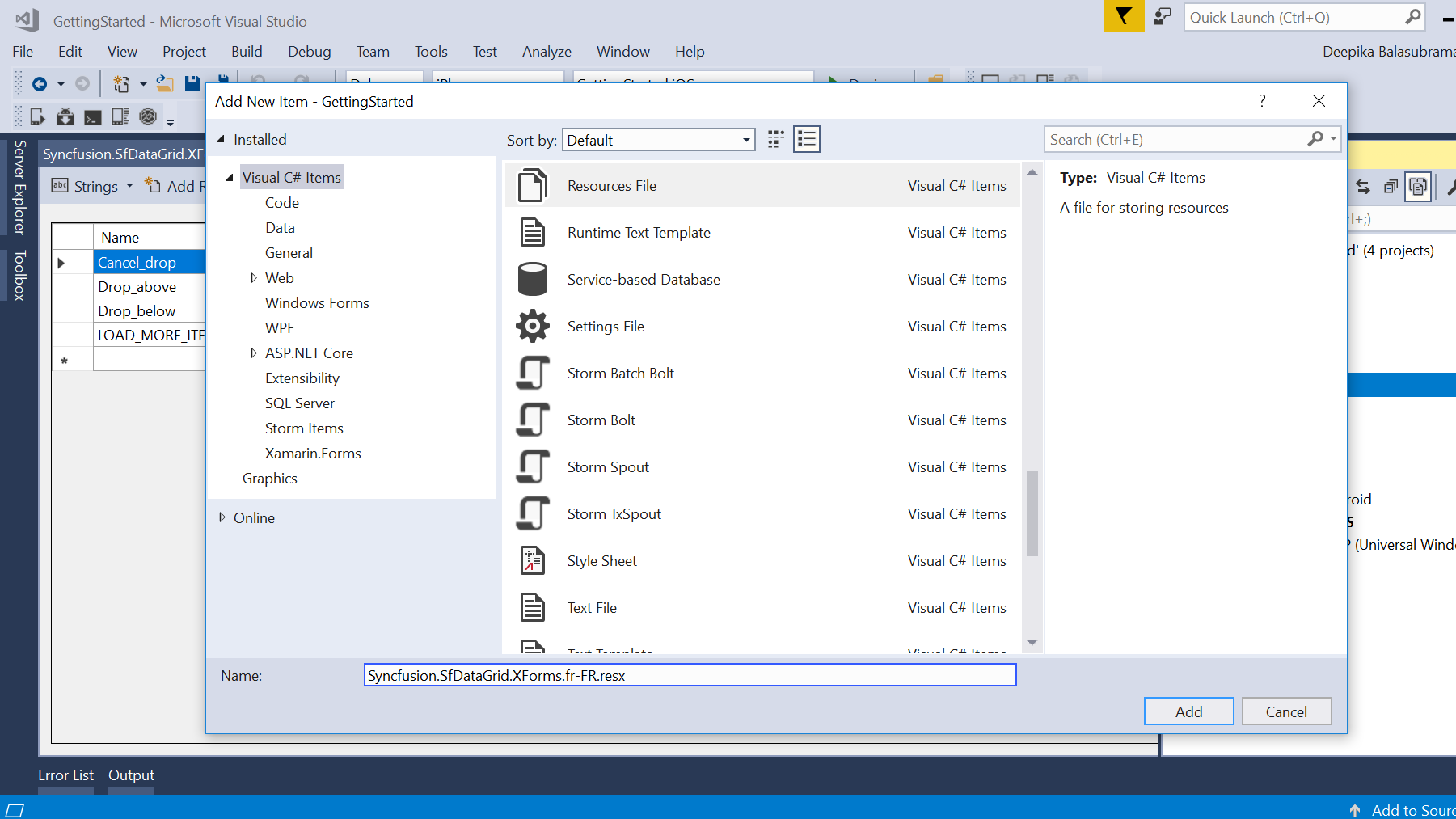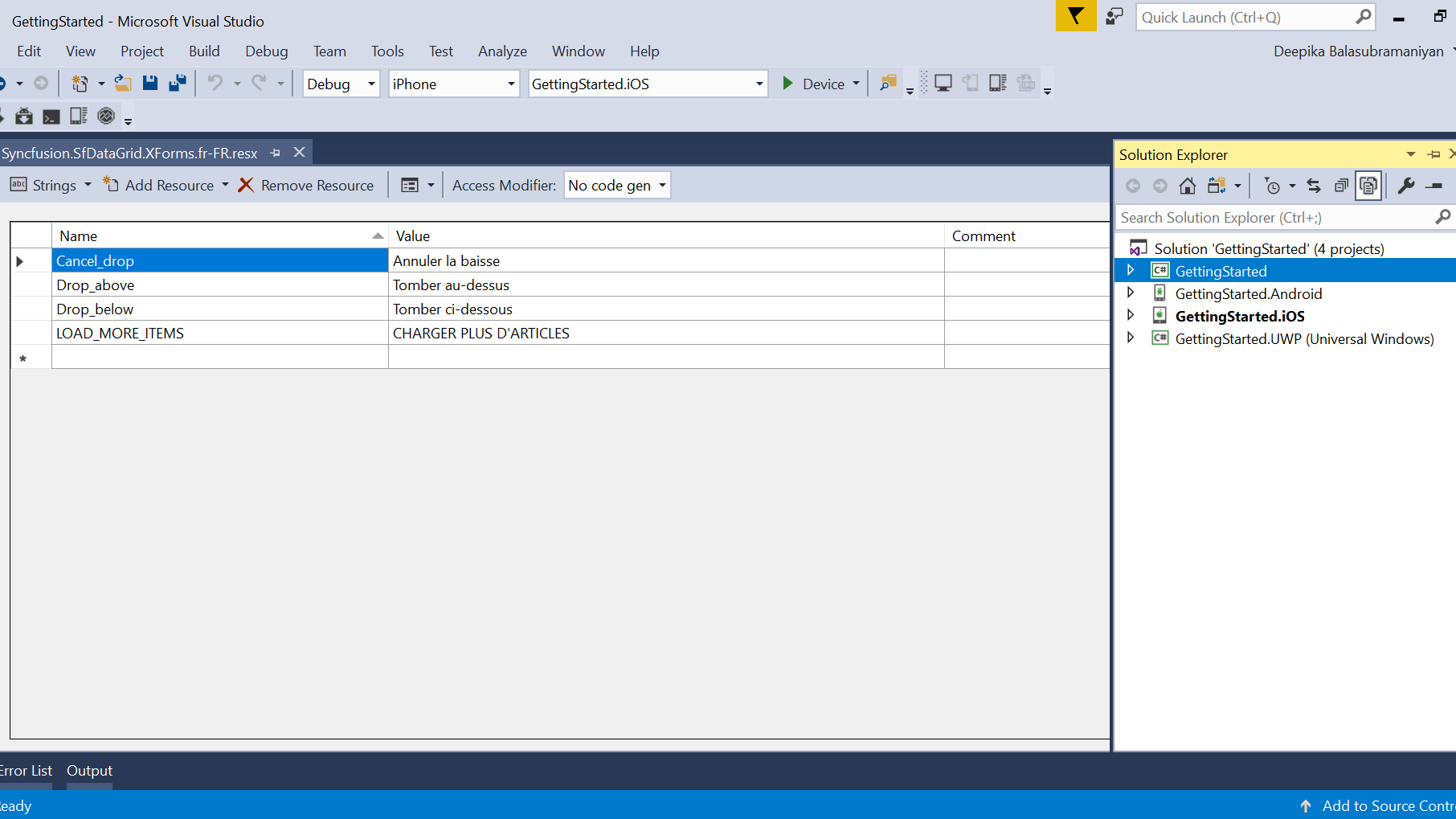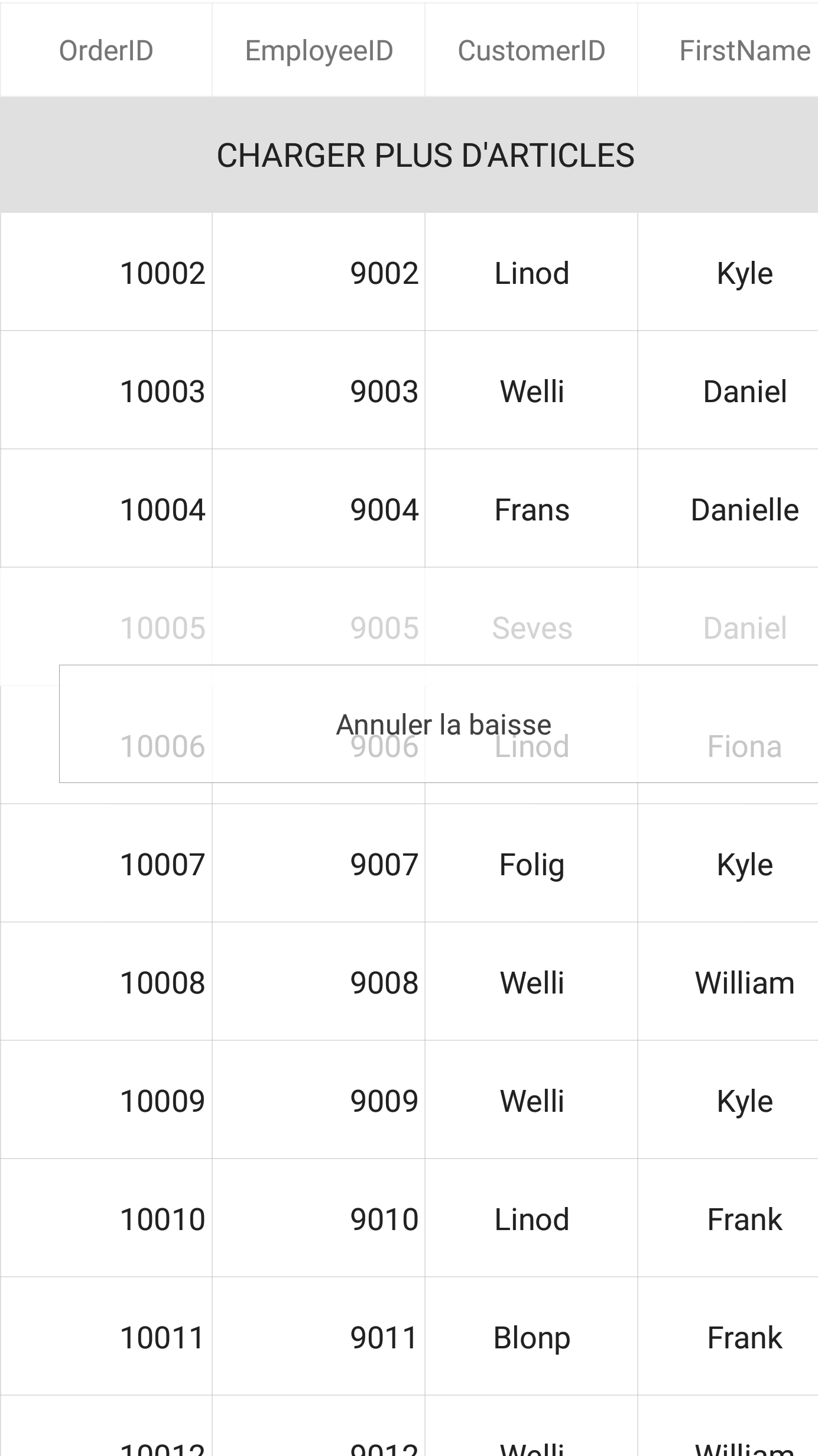Localization in Xamarin DataGrid (SfDataGrid)
10 Jan 202518 minutes to read
Localization is the process of translating application resources into different languages for specific cultures. SfDataGrid uses the following static text that can be localized in application level:
- LOAD MORE ITEMS
- Drop below
- Drop above
- Cancel drop
To localize the SfDataGrid, follow the steps in application level:
- Add a .resx file.
- Convert the platform specific language format to .NET format.
- Apply the converted format.
Add a .resx file
In the portable project of your application, add a .resx file inside the resources folder with Build Action -> EmbeddedResource. The file name should be Syncfusion® control's Namespace + language code format.
For example, to set the culture as French, the file should be named as Syncfusion.SfDataGrid.XForms.fr-FR.resx.

Based on the language, set the appropriate equivalent text to the static text in the .resx file.
NOTE
You should create and add separate .resx files for the individual languages.

Convert the platform specific language format to .NET format
To get the localized text from the added .resx file, declare an interface named ILocalize in your PCL project and implement the interface in each platform renderer. This will query the language set in the device using platform specific code and convert this platform specific format to .NET format.
Refer to the following code snippet to declare the interface in PCL project.
public interface ILocalize
{
CultureInfo GetCurrentCultureInfo();
void SetLocale(CultureInfo cultureInfo);
}
public class PlatformCulture
{
public PlatformCulture(string platformCultureString)
{
if (String.IsNullOrEmpty(platformCultureString))
throw new ArgumentException("Expected culture identifier", "platformCultureString"); // in C# 6 use NameOf(platformCultureString)
PlatformString = platformCultureString.Replace("_", "-"); // .NET expects dash, not underscore
var dashIndex = PlatformString.IndexOf("-", StringComparison.Ordinal);
if (dashIndex > 0)
{
var parts = PlatformString.Split('-');
LanguageCode = parts[0];
LocaleCode = parts[1];
}
else
{
LanguageCode = PlatformString;
LocaleCode = "";
}
}
public string PlatformString
{
get; private set;
}
public string LanguageCode
{
get; private set;
}
public string LocaleCode
{
get; private set;
}
public override string ToString()
{
return PlatformString; ;
}
}Refer to the following code to implement the interface in Android renderer project.
public class Localize : ILocalize
{
public void SetLocale(CultureInfo cultureInfo)
{
Thread.CurrentThread.CurrentCulture = cultureInfo;
Thread.CurrentThread.CurrentUICulture = cultureInfo;
}
public CultureInfo GetCurrentCultureInfo()
{
var netLanguage = "en";
var androidLocale = Java.Util.Locale.Default;
netLanguage = AndroidToDotnetLanguage(androidLocale.ToString().Replace("_", "-"));
// this gets called a lot - try/catch can be expensive so consider caching or something
CultureInfo cultureInfo = null;
try
{
cultureInfo = new CultureInfo(netLanguage);
}
catch
{
// iOS locale not valid .NET culture (eg. "en-ES" : English in Spain)
// fallback to first characters, in this case "en"
try
{
var fallback = ToDotnetFallbackLanguage(new PlatformCulture(netLanguage));
cultureInfo = new CultureInfo(fallback);
}
catch
{
// iOS language not valid .NET culture, falling back to English
cultureInfo = new CultureInfo("en");
}
}
return cultureInfo;
}
private string AndroidToDotnetLanguage(string androidLanguage)
{
var netLanguage = androidLanguage;
//certain languages need to be converted to CultureInfo equivalent
switch (androidLanguage)
{
case "ms-BN": // "Malaysian (Brunei)" not supported .NET culture
case "ms-MY": // "Malaysian (Malaysia)" not supported .NET culture
case "ms-SG": // "Malaysian (Singapore)" not supported .NET culture
netLanguage = "ms"; // closest supported
break;
case "in-ID": // "Indonesian (Indonesia)" has different code in .NET
netLanguage = "id-ID"; // correct code for .NET
break;
case "gsw-CH": // "Schwiizertüütsch (Swiss German)" not supported .NET culture
netLanguage = "de-CH"; // closest supported
break;
// add more application-specific cases here (if required)
// ONLY use cultures that have been tested and known to work
}
return netLanguage;
}
private string ToDotnetFallbackLanguage(PlatformCulture platformCulture)
{
var netLanguage = platformCulture.LanguageCode; // use the first part of the identifier (two chars, usually);
switch (platformCulture.LanguageCode)
{
case "gsw":
netLanguage = "de-CH"; // equivalent to German (Switzerland) for this app
break;
// add more application-specific cases here (if required)
// ONLY use cultures that have been tested and known to work
}
return netLanguage;
}
}Refer to the following code to implement the interface in iOS renderer project.
public class Localize : ILocalize
{
public void SetLocale(CultureInfo cultureInfo)
{
Thread.CurrentThread.CurrentCulture = cultureInfo;
Thread.CurrentThread.CurrentUICulture = cultureInfo;
}
public CultureInfo GetCurrentCultureInfo()
{
var netLanguage = "en";
if (NSLocale.PreferredLanguages.Length > 0)
{
var pref = NSLocale.PreferredLanguages[0];
netLanguage = iOSToDotnetLanguage(pref);
}
// this gets called a lot - try/catch can be expensive so consider caching or something
CultureInfo cultureInfo = null;
try
{
cultureInfo = new CultureInfo(netLanguage);
}
catch
{
// iOS locale not valid .NET culture (eg. "en-ES" : English in Spain)
// fallback to first characters, in this case "en"
try
{
var fallback = ToDotnetFallbackLanguage(new PlatformCulture(netLanguage));
cultureInfo = new CultureInfo(fallback);
}
catch
{
// iOS language not valid .NET culture, falling back to English
cultureInfo = new CultureInfo("en");
}
}
return cultureInfo;
}
private string iOSToDotnetLanguage(string iOSLanguage)
{
var netLanguage = iOSLanguage;
//certain languages need to be converted to CultureInfo equivalent
switch (iOSLanguage)
{
case "ms-MY": // "Malaysian (Malaysia)" not supported .NET culture
case "ms-SG": // "Malaysian (Singapore)" not supported .NET culture
netLanguage = "ms"; // closest supported
break;
case "gsw-CH": // "Schwiizertüütsch (Swiss German)" not supported .NET culture
netLanguage = "de-CH"; // closest supported
break;
// add more application-specific cases here (if required)
// ONLY use cultures that have been tested and known to work
}
return netLanguage;
}
private string ToDotnetFallbackLanguage(PlatformCulture platCulture)
{
var netLanguage = platCulture.LanguageCode; // use the first part of the identifier (two chars, usually);
switch (platCulture.LanguageCode)
{
//
case "pt":
netLanguage = "pt-PT"; // fallback to Portuguese (Portugal)
break;
case "gsw":
netLanguage = "de-CH"; // equivalent to German (Switzerland) for this app
break;
// add more application-specific cases here (if required)
// ONLY use cultures that have been tested and known to work
}
return netLanguage;
}
}Implementation of the interface is not required for UWP project, since the resources automatically recognizes the selected language.
Apply the converted format
After setting the root/main page of the application in your App.Xaml.cs file of the PCL project, initialize a new instance of the ResourceManager class and set it to the DataGridResourceManager.Manager property to look up into the resources with specified root name in the given assembly. Using DependencyService, call SetLocale() of the implemented interface with necessary language code as parameter.
public partial class App : Application
{
public App()
{
InitializeComponent();
MainPage = new GettingStarted.MainPage();
if (Device.RuntimePlatform == Device.iOS || Device.RuntimePlatform == Device.Android)
{
DataGridResourceManager.Manager = new ResourceManager("GettingStarted.Resources.Syncfusion.SfDataGrid.XForms", this.GetType().GetTypeInfo().Assembly);
// the ResourceManager class constructor has two parameters.
// 1. ResXPath => Full path of the resx file in the application. Here in the above line GettingStarted refers to the namespace of the Application
// 2. Assembly => Application assembly (PCL)
// Sets the required culture to the static texts in the control.
DependencyService.Get<ILocalize>().SetLocale(new CultureInfo("fr-FR"));
}
}
}For Android and iOS, it is mandatory to implement the previous steps. However, to set a specific language to the application irrespective of the selected language in the device, use CultureInfo.CurrentUICulture in a specific project of UWP platform.
Refer to the following code example to localize the text in UWP platform.
MainPage.Xaml.cs
public MainPage()
{
this.InitializeComponent();
SfDataGridRenderer.Init();
// Applying localization for UWP
CultureInfo.CurrentUICulture = new CultureInfo("fr");
LoadApplication(new GettingStarted.App());
}
You can download the sample here.
NOTE
You can refer to our Xamarin DataGrid feature tour page for its groundbreaking feature representations. You can also explore our Xamarin.Forms DataGrid example to knows various chart types and how to easily configured with built-in support for creating stunning visual effects.